Mass Hysteria
Even the Dutch would now get embarrassed reading the newspapers and magazines appearing at the time of the race. This was in the Crisis and a welcome relief from the dreary news about Hitler climbing to power in Germany. At least Holland seemed to hold its own. Jan de Hartog describes the national fame of the ocean tugs' captains, one of which even had a cigar named after him. These guys and the Uiver crew members were regarded as heroes, just as much as those from Holland's heyday when explorers like van Diemen discovered Australia and Admiral Michiel de Ruyter sailed up the Thames and ransacked London. Holland's Glory!
The Dutch have always had an incredible affection for their KLM anyway. Not taking anything away from the exploits of the Uiver crew, the insane mob scenes upon their arrival back in Amsterdam are hard to believe. The same happened when the first East India flight came back, and on other occasions.One of those, which served to make that real to me was when, in 1973, we arrived in Amsterdam with the Dakota we had been shooting a movie with in the Caribbean. Granted, it must have been one of the last occasions when a DC-3 took passengers over the ocean: besides the crew it carried part of the film crew. But, after all, it was only twenty years ago or even less that this had been quite normal, so the way we were received there by an enthusiastic mob of Schiphol workers was downright embarrassing. As good as being carried along on shoulders, we were taken right past nonsense like customs etc., and it was then that I discovered there was a staircase at Schiphol that took you right past all these obstructions. (It was not so easy to find, a pity.)
|
Café de Uiver and more
At least until the 1980s this the Hague bar, across the street from Staatsspoor station (now Central Station), sported a propeller on the façade.
Too bad it was a wooden 2-blade prop, while the DC-2 used 3-bladen metal props.)
Apart from the bonanza it was to newspapers and magazines, books were published. There even was a De Vliegende Hollander [the Flying Dutchman] march (vivace!). One book was Met de UIVER naar Melbourne [With the Uiver to Melbourne, by Ron Heerkens] for the Dutch youth. It's full of passages like (I'm not quoting verbally) our intrepid heroes , our Dutch boys , the patriotic crew ... enough already. It certainly doesn't fail to draw a parallel between the 17th century Dutch Golden Age exploits and this new historic landmark.
I must admit I have often wondered how many non-Dutch people know about this at all. Or about the Fokker trips to the Indies. (For example, in Flyaway Desmond Bagley merely mentions the England-Australia air race of 1934, won by Scott and Campbell-Black. ) One thing is for sure, the mentality of the KLM flyers was very much like Plesman's, who certainly must have thought along the same lines. Push up Holland in the world, blah blah.
Even the books of Viruly are stiff with those ideas. Viruly, a long-time KLM captain whose career came to an end with a Shannon crash of Constellation Triton wrote several books. I guess they will never be translated from Dutch, they just aren't worth it. They're not bad; Jan de Hartog even wrote an intro to one of them, but there's much better stuff around. My favorite is Ernest K. Gann, but even Antoine de Saint Exupéry is much better at describing what it feels like to be in a cockpit, if much too flowery. Viruly is much more influenced by the latter, which figures, place and time being what they were. But it tends to make him too mystical for the Zeeuw he really was.
Like de Hartog, Viruly was a pacifist who ran into trouble because of KLM's military-like organization and discipline—right down to the low pay and bad conditions of the real army.
A much more recent book is De legendarische vlucht van de Uiver [The legendary flight of the Uiver] by Wim Kroese. This is, in itself, much more subdued and mainly consists of contemporary newspaper cuttings etc, presented with no comment. Much of the material on the Fokker-Plesman controversy came from there. Still, legendary? I guess only in Holland.
In the 1950s KLM tried to drum up the same feelings for the Christchurch race to New Zealand. Again they won, this time in a DC-6, but nobody seemed to care so much by then. |
Aftermath
Uiver's success must have confirmed Plesman he had been right upon going for the all-metal Douglas aircraft. Even so, it was not the end for the Fokker factories by a long way. First, the 1939 F-24 was on a par with the contemporary DC-5, and for both only WWII stopped the model's production. The F-24 eventually was even turned into the F-27—for a twenty years old original concept with a World War and all its technological progress having passed, that's pretty good.
On the other hand, the traditionally constructed Fokker aircraft F-32 and F-36 were far ahead of the metal aircraft produced in the USA as far as capacity and comfort was concerned. And who knows, safety as well. Only with the Lockheed Constellation which really entered production only after WWII, ten years later, the all-metal aircraft reached the same standards. But they weren't what you'd call safe .
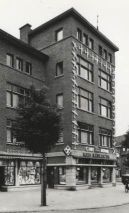
This was Fotohandel Nieuwenhuis in Den Haag, Netherlands,
decorated all over with Uiver cut-outs.
The way the aircraft seems to crash at the end of the trip seems prophetic.
In the mid 1960s, I worked in that building, which then housed a publisher.
My desk was on the second floor, behind the window on the right.
And How About Melbourne?
With this background of Dutch air history, I naturally was interested in finding an exhibit in the Melbourne Museum dedicated to that very same Melbourne race. Big surprise? Not really: the KLM Uiver is not even mentioned. Here are some photographs, look for yourself.
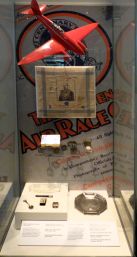
Exhibition Case
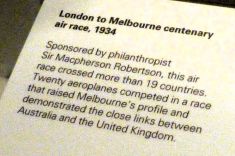 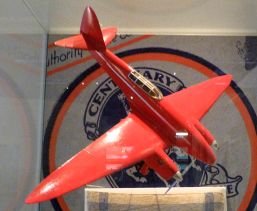
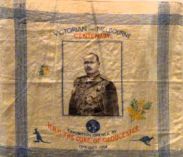
Text — De Havilland DH-88 Comet — Exhibition Handkerchief
I spare you the cookie cutters and obligatory ashtray.
It's sadly ironic that De Havilland later called their what was the first commercial passenger jet Comet as well.
The aircraft had a series of mishaps, which faults were later corrected. It is still flying these days as the Nimrod.
Conclusion
My conclusion, for what it's worth, is that Plesman was dead wrong in leaving Fokker for Douglas. Fokker's aircraft just were better and he did switch construction methods when the time was ripe for him. It was more the whim of Plesman that decided. Plesman was much more of a self-kicker (his KLM ) and less of a patriot than generally thought, and if WWII had not broken out things might have gone very differently (sounds familiar, that.)
Fokker, not patriotic at all, has the last laugh anyway—first, his factory built Douglas and Lockheed planes under license; and his name is still very well known beyond the dykes.
Post Script
The Dutch have now restored a DC-2, which, naturally, they have baptized Uiver. What is just as natural, they make out this is the original Uiver. It's put very slyly, so you can't accuse the propaganda-makers of an outright lie, but the unsuspecting reader will draw the conclusion that this is the original machine. This is the most subtle way to falsify history.
However, the Uiver crashed in 1934, one year after the Melbourne triumph. Crew exhaustion must have been the main cause.
The Crash
It has been suggested that Uiver was shot down by RAF-aircraft because on of the passengers was a Dutch-Indonesian businessman Dominique Berretty, who had his own press agency, was alleged to be a spy for Japan and had an affair with one of Dutch governor De Jonge's daughters. Even if this were true, it sounds like outrageous that this would be the only way to get rid of the man.
Also, the aircraft was off course in heavy weather conditions. The official report assumes a lightning strike that killed all aboard after which the plane crashed with landing gear up; it also quotes stability problems, incorrect weather reports, and a tired crew which had been flying far too long; captain Beekman had fought a "physically and spiritually" exhaustive labor conflict with KLM-management; extensive changes had been made to the aircraft to correct many technical deficiencies KLM pilots complained about, just before take-off from Amsterdam.
|
|







